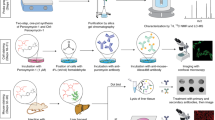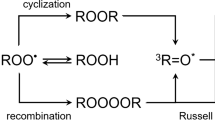Abstract
In all living cells, levels of reactive oxygen species are kept in check by antioxidative activities. Superoxide radicals are dismutated by superoxide dismutases, by other enzymes and by nonenzymatic compounds. This protocol describes the quantification of superoxide scavenging activities (SOSA). It is based on the inhibition of chemiluminescence emitted by coelenterazine when oxidized by superoxide. SOSA is a summary parameter comprising all high-molecular-weight superoxide scavengers in a biological sample. Enzymes and nonenzymatic scavengers can also be distinguished. The SOSA assay is quick, reproducible and applicable to fields as diverse as medical diagnostics, food sciences, or agriculture. The protocol presented here requires about 2 working days to complete.
This is a preview of subscription content, access via your institution
Access options
Subscribe to this journal
Receive 12 print issues and online access
$259.00 per year
only $21.58 per issue
Buy this article
- Purchase on Springer Link
- Instant access to full article PDF
Prices may be subject to local taxes which are calculated during checkout






Similar content being viewed by others
References
Chen, S. et al. Penicillin-enhanced chemiluminescence of the luminol-H2O2-Co2+ system. J. Pharm. Sci. 80, 1017–1019 (1991).
Elstner, E.F. (ed). Der Sauerstoff—Biochemie, Biologie, Medizin (BI-Wissenschaftsverlag, Mannheim, Germany, 1990).
Alscher, R.G., Erturk, N. & Heath, L.S. Role of superoxide dismutases (SODs) in controlling oxidative stress in plants. J. Exp. Bot. 53, 1331–1341 (2002).
Bowler, C., Van Montagu, M. & Inze, D. Superoxide dismutase and stress tolerance. Annu. Rev. Plant. Biol. 43, 83–116 (1992).
Scandalios, J.G. Oxygen stress and superoxide dismutases. Plant Physiol. 101, 7–12 (1993).
Hagermann, A.E. et al. High molecular weight plant polyphenolics (tannins) as biological antioxidants. J. Agric. Food Chem. 46, 1887–1892 (1998).
Kuda, T., Hishi, T. & Maekawa, S. Antioxidant properties of dried product of 'haba-nori', an edible brown alga, Petalonia binghamiae (J. Agaradh) Vinogradova. Food Chem. 98, 545–550 (2006).
Saleh, L. & Plieth, C. Total low-molecular-weight antioxidants as a summary parameter, quantified in biological samples by a chemiluminescence inhibition assay. Nat. Protoc., advance online publication, 16 September 2010, doi:10.1038/nprot.2010.120.
Lissi, E., Pascual, C. & del Castillo, M.D. On the use of quenching of luminol luminescence to evaluate SOD activity. Free Radic. Biol. Med. 16, 833–837 (1994).
Pascual, C., Castillo, M.D.d. & Romay, C. A new luminol sensitized chemiluminescence method for determination of superoxide dismutase. Anal. Lett. 25, 837–849 (1992).
Liochev, S.I. & Fridovich, I. Lucigenin (bis-N-methylacridinium) as a mediator of superoxide anion production. Arch. Biochem. Biophys. 337, 115–120 (1997).
Roberts, P.A., Knight, J. & Campbell, A.K. Pholasin-A bioluminescent indicator for detecting activation of single neutrophils. Anal. Biochem. 160, 139–148 (1987).
Molecular Probes, Inc. Coelenterazine and coelenterazine derivatives. Product Information <http://probes.invitrogen.com/media/pis/mp02944.pdf> (2001).
Teranishi, K. & Shimomura, O. Coelenterazine analogs as chemiluminescent probe for superoxide anion. Anal. Biochem. 249, 37–43 (1997).
Kervinen, M., Pätsi, J., Finel, M. & Hassinen, I.E. Lucigenin and coelenterazine as superoxide probes in mitochondrial and bacterial membranes. Anal. Biochem. 324, 45–51 (2004).
Miller, E.K. & Fridovich, I. A demonstration that O2− is a crucial intermediate in the high quantum yield luminescence of luminol. J. Free Radic. Biol. Med. 2, 107–110 (1986).
Tarpey, M.M. et al. Chemiluminescent detection of oxidants in vascular tissue: lucigenin but not coelenterazine enhances superoxide formation. Circ. Res. 84, 1203–1211 (1999).
Vásquez-Vivar, J. et al. Superoxide anion formation from lucigenin: an electron spin resonance spin-trapping study. FEBS Lett. 403, 127–130 (1997).
Wardman, P. et al. Pitfalls in the use of common luminescent probes for oxidative and nitrosative stress. J. Fluoresc. 12, 65–68 (2002).
Rees, J.F. et al. The origins of marine bioluminescence: turning oxygen defence mechanisms into deep-sea communication tools. J. Exp. Biol. 201, 1211–1221 (1998).
de Wergifosse, B. et al. Coelenterazine: a two-stage antioxidant in lipid micelles. Free Radic. Biol. Med. 36, 278–287 (2004).
Fridovich, I. Quantitative aspects of the production of superoxide anion radical by milk xanthine oxidase. J. Biol. Chem. 245, 4053–4057 (1970).
Hille, R. Structure and function of xanthine oxidoreductase. Eur. J. Inorg. Chem. 2006, 1913–1926 (2006).
Vorbach, C., Harrison, R. & Capecchi, M.R. Xanthine oxidoreductase is central to the evolution and function of the innate immune system. Trends Immunol. 24, 512–517 (2003).
Camejo, D. et al. Response of superoxide dismutase isoenzymes in tomato plants (Lycopersicon esculentum) during thermo-acclimation of the photosynthetic apparatus. Physiol. Plant. 131, 367–377 (2007).
Saleh, L. & Plieth, C. Fingerprinting antioxidative activities in plants. Plant Methods 5, 2 (2009).
Ziobro, A. & Bartosz, G. A comparison of the total antioxidant capacity of some human body fluids. Cell Mol. Biol. Lett. 8, 415–419 (2003).
Wippich, N. et al. Comparison between xanthine oxidases from buttermilk and microorganisms regarding their ability to generate reactive oxygen species. Int. J. Mol. Med. 7, 211–216 (2001).
Plieth, C. Aequorin as a reporter gene. in Arabidopsis Protocols Vol. 323 (eds. Salinas, J. & Sanchez-Serrano, J.J.) (Humana Press, Totowa, New Jersey, 2006).
de Lamirande, G., Allard, C. & Cantero, A. Purine-metabolizing enzymes in normal rat liver and Novikoff hepatoma. Cancer Res. 18, 952–958 (1958).
Acknowledgements
We thank L. Shaw (Kiel) for critically reading the paper. We also thank S. Vollbehr, G. Weppner and S. Anderson for technical assistance; J. Scheller (Institute for Biochemistry, University of Kiel) for providing HepG2 cells; B. Bryan of Prolume for the generous gift of coelenterazine; and A. Scheidig (Structural Biology Group, Kiel) and U.-P. Hansen (Biophysics Group, Kiel) for their generous support. We gratefully acknowledge the financial support of the Deutsche Forschungsgemeinschaft (Grant no. PL253/5), as well as access to the core facilities of the Zentrum für Biochemie und Molekularbiologie, Christian-Albrechts-Universität, Kiel.
Author information
Authors and Affiliations
Contributions
L.S. carried out the experiments reported in the main paper, performed data processing and participated in amending the draft. C.P. conceived of the protocol, carried out the experiments shown in the supplementary information and wrote the paper. Both authors approved the final version.
Corresponding author
Ethics declarations
Competing interests
The authors declare no competing financial interests.
Supplementary information
Supplementary Table 1
Coelenterazine analogues, their generic names, synonyms, and commercial sources. (PDF 10 kb)
Supplementary Note 1
Acetaldehyde is a less favourable substrate for xanthine oxidase in the SOSA assay. Anaerobic organisms may contain superoxide reductase instead of SOD. (PDF 12 kb)
Supplementary Note 2
The signal to background ratio of coelenterazine luminescence produced by different CTZ analogues. (PDF 19 kb)
Rights and permissions
About this article
Cite this article
Saleh, L., Plieth, C. A coelenterazine-based luminescence assay to quantify high-molecular-weight superoxide anion scavenger activities. Nat Protoc 5, 1635–1641 (2010). https://doi.org/10.1038/nprot.2010.121
Published:
Issue Date:
DOI: https://doi.org/10.1038/nprot.2010.121
This article is cited by
-
Dronedarone induces regression of coronary artery remodeling related to better global antioxidant status
Hypertension Research (2019)
-
Reactive Oxygen Species Imaging in a Mouse Model of Inflammatory Bowel Disease
Molecular Imaging and Biology (2016)
-
Photo-Reaction Mechanism of the Hydrated Superoxide Anion: A Theoretical Study
Journal of Solution Chemistry (2014)
-
Total low-molecular-weight antioxidants as a summary parameter, quantified in biological samples by a chemiluminescence inhibition assay
Nature Protocols (2010)
Comments
By submitting a comment you agree to abide by our Terms and Community Guidelines. If you find something abusive or that does not comply with our terms or guidelines please flag it as inappropriate.



